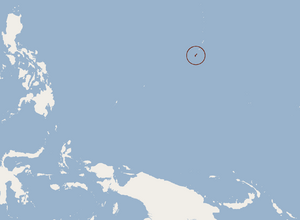Guam flying fox facts for kids
Quick facts for kids Guam flying fox |
|
|---|---|
| Conservation status | |
| Scientific classification | |
| Genus: |
Pteropus
|
| Species: |
tokudae
|
 |
|
The Guam flying fox (Pteropus tokudae) was a type of very large bat. It was also called the little Marianas fruit bat. This bat lived on the island of Guam in the Marianas Islands. These islands are part of Micronesia. Scientists have confirmed that this bat is now extinct. This means it has completely disappeared from Earth. It likely died out because of hunting or changes to its habitat (its natural home).
The first time this bat was officially recorded was in 1931. People saw it resting with the much larger Mariana fruit bat. The last time a Guam flying fox was seen was in March 1967. It was a female bat found at Tarague cliff, but it got away. Someone reported seeing one in the 1970s, but this was not confirmed. No one has seen any since then.
Contents
What the Guam Flying Fox Looked Like
The Guam flying fox was about 15 cm (6 in) long. Its wings could spread out to about 70 cm (28 in). It weighed around 152 g (5.4 oz). This bat looked very similar to the Chuuk flying fox (Pteropus insularis).
Its head was greyish on top. Its back, throat, and belly were brown or dark brown. The sides of its neck were a golden-brown color.
How the Guam Flying Fox Lived
Scientists do not know much about how the Guam flying fox behaved. It probably ate fruits, flowers, and leaves. These would have come from evergreen shrubs and trees. These plants grow in the limestone forests in northern Guam.
Not much is known about how it had babies either. However, in 1968, a female bat was seen with a young bat. This suggests that parent bats might have cared for their young for some time.
Why the Guam Flying Fox Disappeared
There have been no confirmed sightings of this bat since the 1970s. The IUCN lists it as "Extinct". This means it is gone forever.
When there were more of these bats, people hunted them for food. This hunting might have helped cause their extinction. Another reason could be the arrival of the Brown tree snake (Boiga irregularis) on the island. This snake is a predator, meaning it hunts other animals for food. It might have eaten the bats.
See also
In Spanish: Zorro volador de Guam para niños


